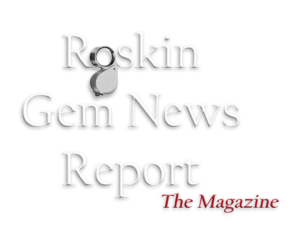Getting seven of the world’s leading gem labs to agree on anything is no small task. Yet for nearly 25 years, the Laboratory Manual Harmonisation Committee (LMHC) has done just that–bringing together experts from America, Asia, and Europe to sit at the same table, compare notes, and hammer out common ground. Their deceptively simple goal: ensure that gemological reports worldwide use consistent language.
On September 29, 2025, the LMHC reported significant progress, unanimously approving three new information sheets that standardize terminology and testing procedures, as well as updating the information sheet covering Fei Cui and jade terminology.
Who or What is the LMHC?
The idea for such a committee began back in 2001, at the request of several colored gemstone dealers who were frustrated with inconsistent report wording. A stone described one way by one professional lab might be labeled differently by another, creating confusion that negatively affected both trust and sales. In response, the LMHC was formed. Bringing together several of the world’s leading gemmological laboratories, today the seven members–CGL (Japan), CISGEM (Italy), DSEF (Germany), GIA (USA), GIT (Thailand), Gübelin Gem Lab (Switzerland), and SSEF (Switzerland)–work side by side to share their gemological opinions and reach a consensus. Their mission is clear: to cooperate on gemological issues that matter to the trade, and, most importantly, to harmonize the language on gemological reports.
These Information Sheets (IS) help the trade, including other laboratories, properly understand the consistent terminology and/or gemological approaches, found on their lab reports. And while their work may not make headlines every day, it underpins the credibility of the reports the trade relies on worldwide.
The newly released harmonized information sheets are as follows:

IS No. 16: Colour Stability Testing of Gemstones (version 1; August 2025)
The new information sheet standardises the method used to test the colour stability of gemstones. It addresses issues where certain colour centres are unstable, potentially resulting in the fading or shifting of a gemstone’s colour following prolonged exposure to daylight.
This phenomenon is specifically observed in certain padparadscha sapphires, fancy sapphires, spodumene, sodalite, or zircon.
The harmonised testing method involves three main steps: (1) careful initial colour grading, (2) exposure to a strong light source for a minimum of three hours to examine for “deactivation”, and (3) subsequent colour grading.
An activation test using UV light is also suggested to check if the colour instability is reversible (reversible photochromism or tenebrescence). Reports mentioning colour stability test results should specify whether the colour is considered stable or not.
IS No. 14: Cobalt Spinel (version 1; May 2025)
The information sheet standardises the nomenclature for blue spinel containing traces of cobalt.
Cobalt spinel is defined as a Mg-Al spinel of blue colour containing traces of cobalt, where the blue colour is mainly due to absorption bands related to cobalt.
*Importantly, spinels coloured by cobalt induced by a treatment process (such as Co-diffusion or filling of fissures with Co-glass) do not qualify to be called cobalt spinel.
The sheet also distinguishes cobalt spinel from blue spinel mainly coloured by iron, noting that if iron bands dominate the absorption spectrum, the stone does not qualify as cobalt spinel.

IS No. 15: Tanzanite (version 1; May 2025)
The information sheet standardises the terminology used in reports about tanzanite.
Tanzanite is defined as the vanadium-bearing blue to purple colour variety of the mineral zoisite. The document notes that tanzanite is strongly pleochroic, and the yellowish-brown pleochroic component can be easily removed by heat treatment, shifting the colour to a distinctly more attractive hue. Consequently, tanzanite is commonly heated, although currently in some cases the treatment is not determinable.

The committee also finalized significant updates to:
LMHC Information Sheet No. 11 (Jade and related Materials) (version 5; May 2025).
Notably, the scope of what constitutes “jade” as a trade name has been clarified to encompass aggregates primarily composed of jadeite, omphacite, kosmochlor, or nephrite.
The complexities surrounding jade, which is an aggregate (rock) that may contain multiple mineral phases, necessitate clear and standardized report language. The new information sheet includes a definition and standardised report wording for Fei Cui (ç¿¡ç¿ ), which is described as a historic Chinese name for a structurally tough ornamental aggregate composed solely or principally of any combination of jadeite, omphacite, and kosmochlor.
The information sheet now specifies that for reports about jadeite jade, omphacite jade, or kosmochlor jade a comment may be added, noting that the material may be called Fei Cui in the Asian trade.
On a Personal Note – Dr. Michael S. Krzemnicki
By standardizing definitions for terms like Fei Cui and outlining required testing, the LMHC hopes to ensure consistency and clarity in laboratory reports for this important material.
“We are very pleased to see that all laboratories represented at LMHC are constructively working together for a harmonisation on issues that are important towards ensuring consistency and clarity in gemmological lab reports,” said Dr. Michael S. Krzemnicki, director of the Swiss Gemmological Institute SSEF, host of the LMHC meeting in Basel. “The release of these new and updated information sheets addresses critical issues impacting disclosure.”
All LMHC Gemstone Information Sheets can be accessed here!
About LMHC The Laboratory Manual Harmonisation Committee (LMHC) draws on the individual experiences of its members with the purpose of creating a general philosophy for proper gemstone nomenclature and disclosure for laboratories, as well as to initiate and suggest “preferable” language to be used on their gemmological reports. LMHC’s goal is to achieve the harmonisation of language on gemmological reports and consequently the revision of this harmonised report language as used by LMHC members. LMHC is currently comprised of representatives from CGL, Japan; CISGEM Laboratory, Italy; DSEF German Gem Lab, Germany; Gübelin Gem Lab, Switzerland; GIA Gem Laboratory, USA; The Gem and Jewelry Institute of Thailand (GIT), Thailand; and the Swiss Gemmological Institute SSEF, Switzerland. LMHC does not maintain formal relationships with special interest groups or trade organizations.













